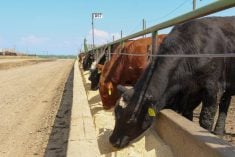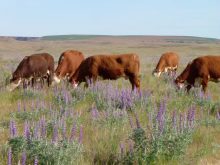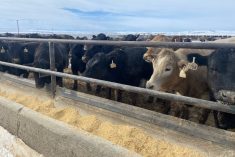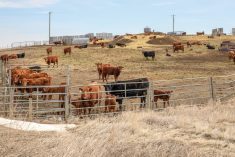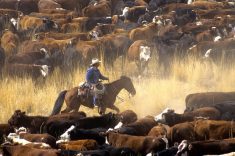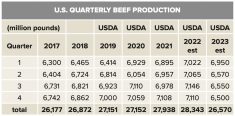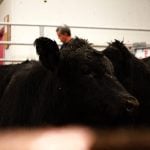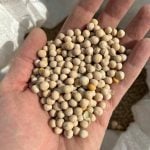Alberta packers were buying fed cattle on a dressed basis in the range of $284-$286 during the second week of May. This is up about $10 from a month earlier. Alberta and Saskatchewan were contending with a backlog of market-ready, fed cattle supplies during the first five months of 2022. However, this burdensome supply situation is slowly being alleviated with the larger slaughter pace and year-over-year increase in fed cattle exports.
The Alberta fed cattle market was trading at a $11-$14 discount to Nebraska values during April. This discount is eroding and we expect the Alberta market to be equal to U.S. values by mid-summer. During the second week of May, medium flesh Simmental mixed steers weighing 875 pounds with full health records on small grain ration were quoted at $190 in central Alberta. Prices for yearlings have also jumped about $10 over the past month. At the same time, calves prices have surged $10 to as much as $15.
Northwest of Winnipeg, a small group of black steers weighing 530 lb. sold for $257 and similar quality heifers weighing 580 lb. dropped the gavel at $202. The feeder cattle fundamentals are positive moving into the summer timeframe. There is also a strong seasonal tendency for the feeder cattle market to rally from the middle of May through early August. This year will be no exception. There are four main factors to consider.
Read Also

Harvest wraps up and fall work begins
At the Eppich famly ranch in western Saskatchewan, the fall harvest was successful with few breakdowns, cows and calves have been sorted and a new tractor has arrived
Factors affecting feeder market

First, Alberta and Saskatchewan feedlot placements from Oct. 1, 2021 through March 31, 2022 were 1.192 million head, up 37,400 from the previous year’s placements of 1.155 million head. Remember, during the winter of 2021, there was a set-aside program due to COVID related issues in the packing industry. This year, there is no set-aside program and cattle on feed numbers have actually been above year-ago levels. This has resulted in the Canadian market trading at a sharp discount to U.S. fed cattle prices. The function of the Alberta market is to encourage exports but there are also constraints in this capacity. Cattle on feed inventories in Alberta and Saskatchewan have been running 10 per cent above year-ago levels throughout the winter. Carcass weights have been sharply higher than last year.
I always run estimates in the fed cattle balance sheets projecting the Canadian slaughter and fed cattle exports to the U.S. Below, shows the number of cattle backed up in Alberta and Saskatchewan feedlots at the end of each month. The backlog at the end of month is the excess number of market-ready fed cattle above the demand projection. Demand is the sum of fed cattle slaughter and exports. By July, the number of market-ready fed cattle are expected to be below demand projections, which will cause the Alberta market to trade at equilibrium to the U.S. market. This should be the start of an upward trend for the Alberta fed cattle market.
Secondly, U.S. feeder cattle placements during the first quarter of 2022 were 5.7 million head, similar to year-ago levels despite the year-over-year decline in the calf crop. According to U.S. crop progress reports, only 18 per cent of the pastures in the U.S. are in good to excellent condition.
The U.S. Southern Plains are experiencing a severe drought. Winter wheat and winter rye prices are sharply higher than last year. Farmers with winter grains have moved cattle off small grain pasture to harvest the wheat. U.S. feeder cattle outside feedlots as of April 1 were 18.903 million head, down 287,000 head from April 1 of 2021. More importantly, this is the lowest number of feeder cattle outside feedlots on April 1 since 2015 when the number was 18.8 million head. U.S. feeder cattle supplies will be rather snug in the latter half of 2022.
Finally, lower feeder cattle supplies will result in lower feedlot placements, which will result in lower beef production during the final quarter of 2022 and first quarter of 2023. The Alberta fed market has been quoted at $310-$315 on a dressed basis and $190 on a live basis. At this stage, we’re factoring in average yields on the Canadian barley crop. I’m looking for weaker feed grain values during the harvest period. Feedlot margins are expected to move into positive territory in the October through December period. This will bode well for the feeder market.
Alberta and Saskatchewan demand for feeder cattle will increase in the late summer period as feedlot inventories drop to seasonal lows. U.S. feeder cattle supplies outside feedlots are similar to 2015. The fed cattle market will reach historical highs during the December 2022 through March 2023 period. Current conditions suggest Western Canada will have average barley yields, which will keep a lid on feed grain prices. All these factors should result in higher feeder cattle prices during the fall and winter of 2022.




